I love finding out about things and I had a few surprises in the garden last week.
Firstly, I was planting some self-seeded Hollyhock plants in front of my Elaeagnus in the back border when I noticed a beautiful jasmine perfume. The Elaeagnus was bought about six years ago as a workhorse to protect and conceal the garden from brambles and overgrowth on the other side. It cost only a few euros and has performed its function as backdrop without complaint or problem despite being overshadowed by tall Ash trees. A couple of years ago two of the Ash trees were blown down in a storm and I now noticed the Elaeagnus had shot up some new branches and was looking happy.
I was surprised that the wonderful perfume was coming from my Elaeagnus. In fact disbelieving is more truthful. I had to search on the internet to convince myself I hadn’t mistaken its name. I discovered that I have probably got Elaeagnus ebbingei.
The leaves start out with this curious speckled pattern.
As the leaf matures it loses this silvery scaling and becomes a dark shiny green.
Now there are lots of little white flowers on the leaf axils.
The outside of the flowers is spotted with brown bark-like dots but the interior is waxen white.
Not perhaps the most beautiful of blossoms but the perfume carries for a distance and the bumble bees appreciate the nectar although I have not, as yet, seen them gather any pollen. I haven’t seen any honeybees on the flowers but the ivy is flowering in the woods around about and they are probably targeting that feast at the moment.
It is interesting to note the different techniques the two bees are using to obtain the nectar. The carder bee is sticking his head inside the flower to reach the nectar and will thereby help to pollinate the flowers by carrying the pollen on his body from flower to flower. The white tailed bumble bee, on the other hand, has a shorter tongue than the carder bee and finds it easier to pierce the tubular flower near its base to reach the nectar. By “stealing” the nectar in this manner it is less likely that she will pollinate the flowers.
While checking out the identity of my Elaeagnus I discovered that the fruits were often edible and that the Elaeagnus angustifolia produced similar yellow, fragrant flowers and a date shaped fruit called senjed. I hadn’t thought about senjed for many years and had never given a thought to where they grow. I like this strange fruit with its dry powdery centre, I suppose because I have always enjoyed trying unusual fruit and I have been rarely disappointed. So Elaeagnus angustifolia is another plant for my wish list as it is listed as having yellow fragrant flowers producing both nectar and pollen for the bees. I just have to find a suitable sunny position for it.
My next surprise is on the front garden wall on the right of the Heptacodium jasminoides which is still in flower and can be seen on the far left of the photograph.
Once again it was the perfume that alerted me that something else was flowering.
This time the flowers are as delicate and beautiful as their perfume but I have never seen a bee on them. In fact, the carder bumble bees fly directly overhead feeding on the hardy fuschia and then returning to the Heptacodium. It seems strange that such perfumed flowers do not attract pollinators but it is not a native european plant so perhaps it has been separated from its pollinating partners.
There are plenty of branches to snip and when brought indoors and put into water the flowers will perfume the room and keep for several days and the leaves for even longer.
From just a short distance away the flowers can hardly be seen but the Osmanthus heterophyllus “Goshiki” is another workhorse, staying evergreen throughout the year, accepting a day long shady position with minimal care in a fast draining soil. The flowers could easily be missed if it wasn’t for the perfume. Such nice surprises!

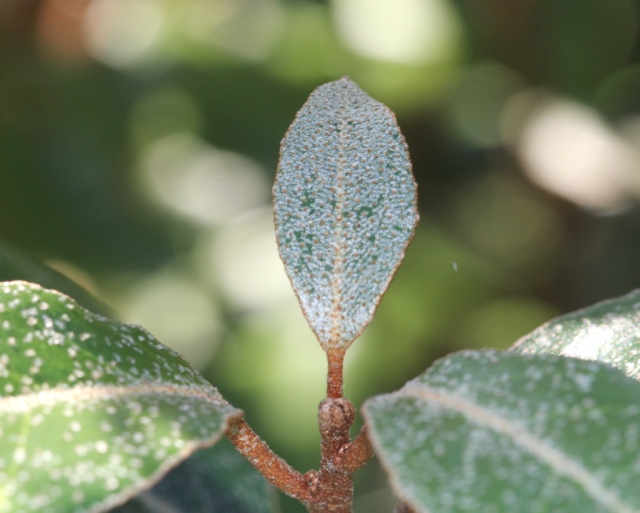


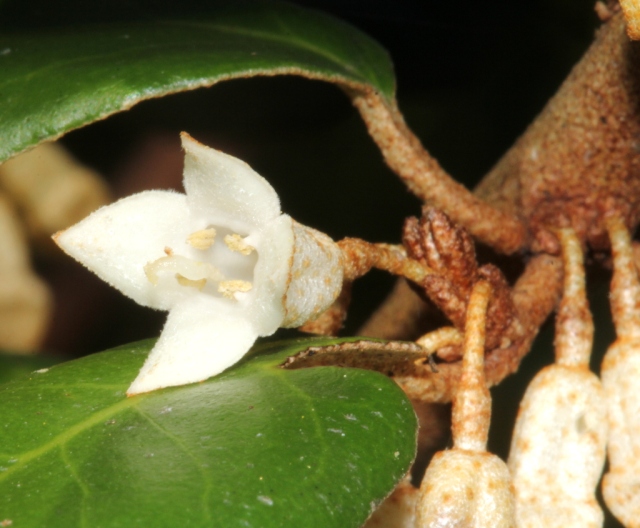
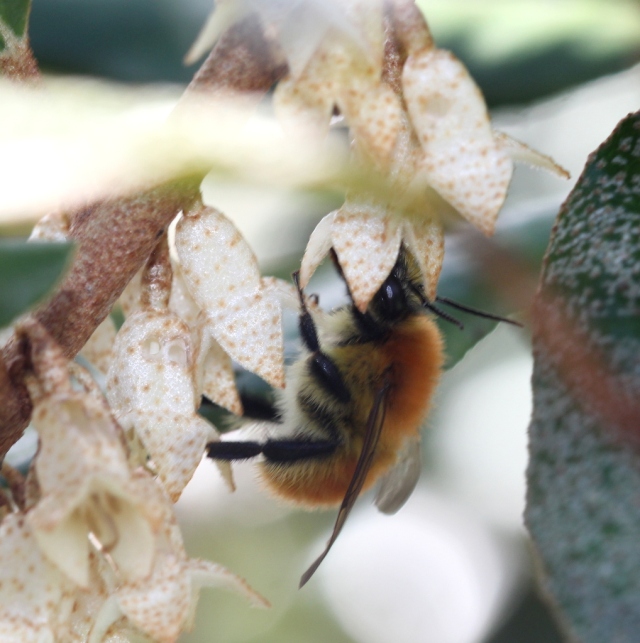

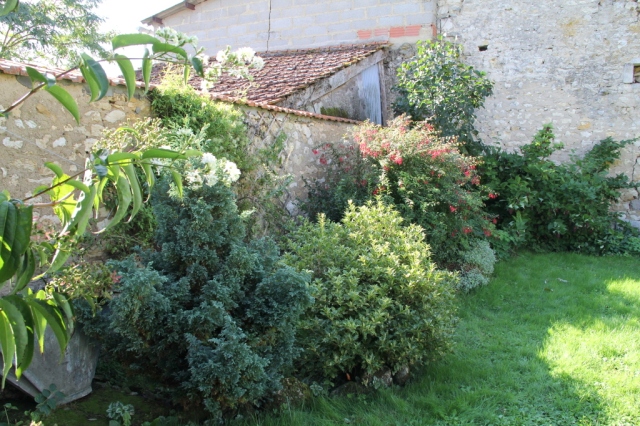


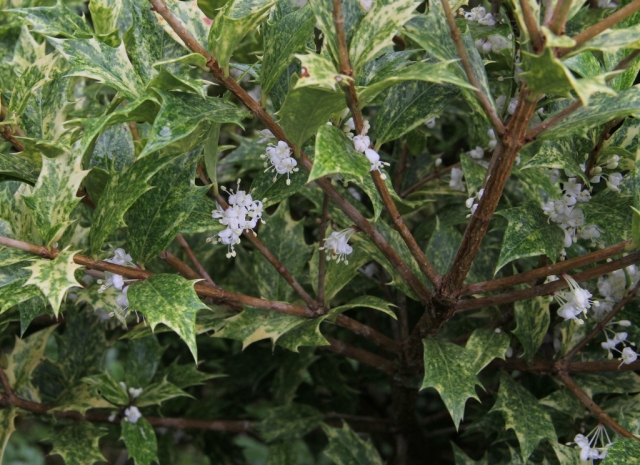
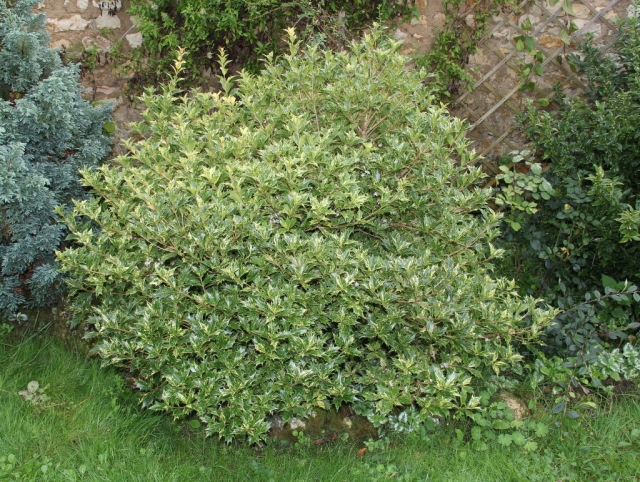
Very instructive reading. And your weather still looks plant-friendly.
I’ve just finished clearing all our flowerbeds, preparing them for winter. I still have some bulbs to plant (a few hour’s worth), and then I’ll be done with the yard for the year.
LikeLike
I’ve still got quite a lot to do. I haven’t even started cutting the things back yet but I still have time. I love spring bulbs but I hate planting them, it takes so long.
LikeLike
Great illustrations of the different ways bees feed.
LikeLike
Thanks, they were very obliging models.
LikeLike
Perfume late in the season is a lovely surprise. Our laurel flowered a second time this autumn, just a little, and the smell was heavenly. I didn’t recognize any of these shrubs you’ve highlighted, so thanks for sharing. I shall have to look them up!
LikeLike
I’ve had a lot of things flowering a second time this year, very strange. I think they are both quite hardy so would suit your garden if you ever needed a sturdy backdrop.
LikeLike
well, glad you noticed it ;), i’ve just planted a second one as i’m sort of addicted to the scent…and i’m not the only one, lots of bees etc. having a good time in the shrub
LikeLike
I think it might need autumn sunshine before it flowers but I’ve no problem with that now. I’m looking forward to getting a second one.
LikeLike
I love the perfume of the eleagnus and that the flowers are so small, as it makes it such a lovely surprise. The flowers of the Heptacodium jasminoides are really pretty.
LikeLike
The perfume is so lovely that I don’t know how I missed reading about it in gardening magazines.
LikeLike
The Heptacodium jasminoides is also called autumn lilac, so it’s not hard to imagine how fragrant your yard is right now.
LikeLike
I had never heard it called that but I think it is a lot less of a mouthful than its Latin name and very appropriate. I do try to buy perfumed shrubs but I was unaware about the Elaeagus perfume. The perfume in the garden is very important to me. We have wild mint in the “lawn” and you can smell it when you walk on it.
LikeLike
I agree, fragrance is very important in a garden. I have thyme in my lawn, but mint is a good idea too.
LikeLike
We have thyme in the back garden too and we let a patch flower for the butterflies but they have both grown up on their own.
LikeLike
What wonderful surprises. I don’t think I have encountered either of those plants but I will keep my eyes open. I like to try unusual fruit too but haven’t yet tried a senjed.
LikeLike
They are very easy plants to grow and are not invasive but perhaps not common in New Zealand.
LikeLike
I have just read a NZ website concerning the development of food forests and Elaeagnus mulitflora (?) is suggested as a top performer for a food forest. I still think it may be difficult to obtain.
LikeLike
Very interesting, I had not heard about that one, perhaps its the more usual species for NZ. I saw a picture of the Goumi berries they produce and they look very similar to the Senjed that I know. As the shrubs fix nitrogen they can survive well in poor soils which is another bonus.
LikeLike
Yes, I thought the nitrogen fixing quality was good too. There is a move to have food forests as part of the redevelopment of Christchurch , post -earthquake, so perhaps we will see more of these plants in our main-stream garden centres, as time goes by.
LikeLike
GREAT POST!!!
LikeLike
Thank you.
LikeLike
Beautiful photos of bumbles foraging eleagnus!
LikeLike
Sorry I have no pictures of honey bees but I’ve been enjoying watching the honey bees on the ivy and they make me laugh when I see how much pollen they are trying to fly with. The ivy is fascinating at the moment, full of so much insect life.
LikeLike
Interesting reading about shrubs I do not know. I will be keeping an eye out for them next time I visit the nursery Thanks. Have a good week Diane
LikeLike
I wonder whether you will see them in the nursery at your next visit? If often happens like that. You have never heard of something and then you can’t help tripping over it.
LikeLike
Lovely, Amelia. An underrated plant! RH
LikeLike
I knew you would like it for the bees.
LikeLike
Interesting and nice to meet these plants, and to see some summer still. We had nearly frost some times, tonight everything is freezing… ;(
LikeLike
Brrrrr.
LikeLike
Now I finally know why a Texas species of Solanum is named elaeagnifolium, meaning ‘having leaves like Elaeagnus.’ Till now I had no idea there’s a plant called Elaeagnus.
LikeLike
I like the link.
LikeLike
If I had a garden I would spend all day there looking for surprises! Another beautiful storytelling post 🙂
LikeLike
Thank you. There always seem to be surprises in gardens if you look.
LikeLike